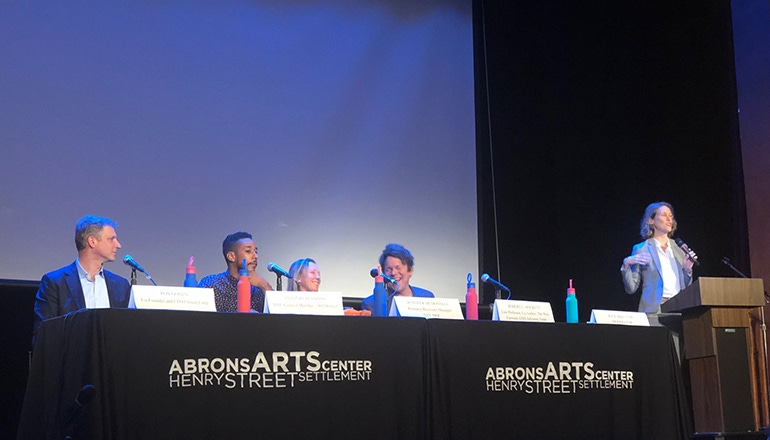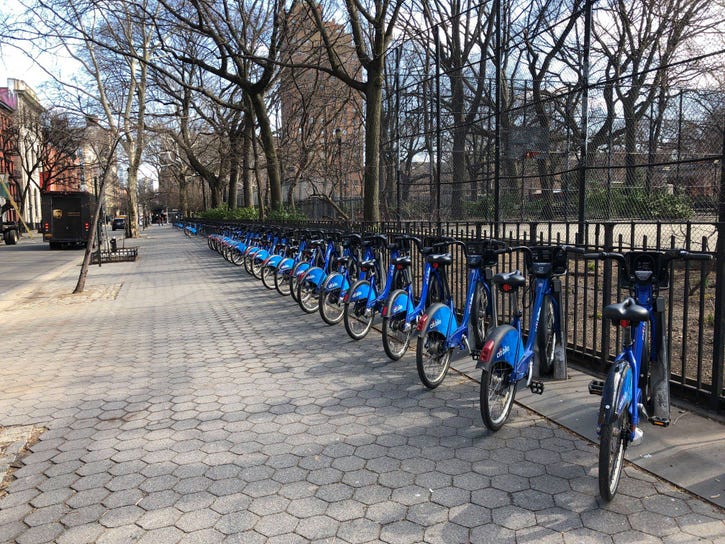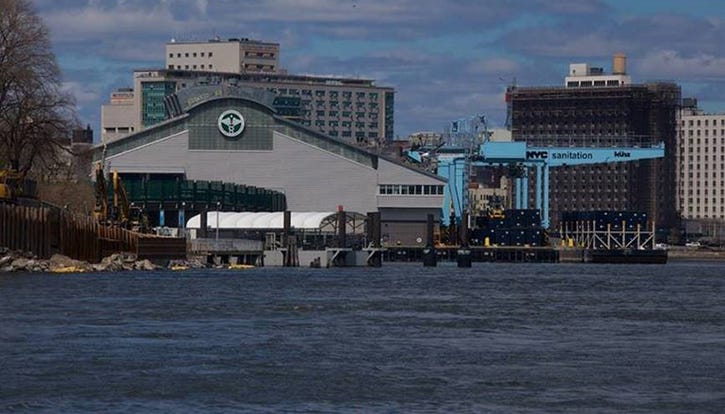The plan comprises $14 billion in new and committed investments, legislation and concrete action at the city level that aim to reduce emissions and generate more jobs.

As the United States explores the possibility of a nationwide Green New Deal, New York City is pushing full speed ahead with its own plan. New York City’s Green New Deal comprises $14 billion in new and committed investments, legislation and concrete action at the city level that aim to achieve a nearly 30 percent additional reduction in emissions by 2030 and generate more jobs.
"Every day we wait is a day our planet gets closer to the point of no return. New York City's Green New Deal meets that reality head on," said New York City Mayor Bill de Blasio in a statement. "We are confronting the same interests that created the climate crisis and deepened inequality. There's no time to waste. We're taking action now, before it's too late."
The Green New Deal policies are outlined in "OneNYC 2050: Building a Strong and Fair City," a new, comprehensive plan to prepare the city for the future and to lead the way for the nation on how to address the threats posed by climate change, economic insecurity, inequity and rising global intolerance.
New York City’s Green New Deal goes hand-in-hand with the de Blasio administration’s previous actions, and together, those actions are expected to lead to a nearly 30 percent reduction in emissions citywide. In combination with actions taken prior to the de Blasio administration, New York City is on track to achieve a 40 percent reduction in emissions from a 2005 baseline by 2030.

The recently announced actions are expected to reduce the city’s emissions by the following percentages from a 2005 baseline:
10 percent: Mandating that all large, existing buildings implement retrofits to be more efficient and lower emissions—a global first.
6 percent: OneNYC initiatives to further reduce emissions including more renewable energy, expanded energy efficiency in buildings and reduced reliance on fossil fuel vehicles.
5 percent: Pursuing a deal to power 100 percent of city operations with clean electricity sources like Canadian hydropower.
2 percent: Cleaning up vehicle fleet and implementing congestion pricing.
In addition to the anticipated 23 percent reduction in emissions from those actions, the de Blasio administration has taken previous actions like phasing out dirtier heating oil that have resulted in a 5 percent reduction. The total reduction secured through actions of the de Blasio administration is expected to reach 28 percent, and when added to reductions made under the prior administration, the city will likely reach a total emissions reduction of 40 percent by 2030, putting it on track for full carbon neutrality by 2050.
New York City’s Green New Deal includes:
Requiring buildings cut their emissions—a global first.
Banning new inefficient glass-walled buildings.
Hydro-powered city government.
Mandatory organics recycling.
Reducing waste and carbon-intensive consumption.
Aligning with the U.N.'s Sustainable Development Goals.
Preparing for the effects of climate change via comprehensive resilience planning.
Solving transportation challenges, such as traffic and the subway system, and reclaiming city streets.
Ensuring social equity and jobs by promoting New Yorkers’ health and building a fairer city for all.
All of these actions tie into the plan’s eight goals that respond to core challenges facing New York City today; 30 initiatives the city and its partners need to undertake to meet those goals by 2050; and more than 80 specific new metrics and targets to guide and hold city leaders accountable.
To provide more insight on New York City’s Green New Deal, the Manhattan Solid Waste Advisory Board hosted a panel on June 20 in Manhattan. The panel, “Is NYC Ready for the New Green Deal?: A Zero Waste Perspective,” featured Robert Hockett, member of U.S. Representative Alexandria Ocasio-Cortez’s Green New Deal team; Antonio Reynoso, NYC council member and chair of the Committee on Sanitation & Solid Waste Management; Ron Gonen, co-founder and CEO of Closed Loop Fund; and Jennifer McDonnell, Resource Recovery Program manager at the New York City Department of Environmental Protection. The panel was moderated by Kate Mikuliak, program manager for strategic policy for the New York City Department of Transportation.
Here’s a deep dive into some of the topics discussed during the panel.
Legislation and Regulation
In the United States—and around the globe—new legislation and regulation are getting passed in an effort to reduce waste, boost recycling and enhance safety.
When asked about what legislation and regulation would complement the Green New Deal, Hockett said, “While regulatory efforts will be an important part of the Green New Deal, proactive action taken by city governments, state governments, institutions, organizations and others is even more important. We want to focus more on what we can do affirmatively and what funding we need to support those actions.”
“The Green New Deal is a long-term, democratic, deliberative process in which the entire population of the country participates,” he added. “On the one hand it’s good to get federal funding and involvement to coordinate the efforts, and [on the other hand] it’s good to get input from the U.S. general public to determine what we ought to be doing. Like the Original New Deal, we intend for the Green New Deal to have projects underway in every congressional district of the country.”
Adding to the discussion, Reynoso addressed two of his bills—the Waste Equity bill (Intro 157-C) and the commercial waste zone bill (Intro 1574).
The Waste Equity bill, which reduces the permitted capacity of waste transfer and recycling processing facilities in selected areas of the city, aims to help “overburdened communities,” but critics say this bill will raise costs, kill jobs and damage the infrastructure necessary to keep the city clean, according to a Crain's New York article.
Backing his legislation, Reynoso said, “I was born on the Southside of Williamsburg, which handles about 40 percent of the city’s trash at about $40 a ton in capacity. It’s a big issue when it comes to the environment, pollution, justice and racism. When you combine the Southside of Williamsburg, South Bronx and Southeast Queens, all of which are cities of color, those areas are handling about 70 percent of the city’s trash. With my legislation, I wanted to reduce the capacity in these communities and have every community handle its own trash, not put the entire burden on a few communities. The legislation was very difficult to pass, but after a lot of watering down, it got passed. My district reduced tonnage by about 40 percent, and Queens and the Bronx reduced tonnage by about 33 percent.”
Reynoso’s next legislative endeavor is the commercial waste zone bill, which would divide the city into at least 20 commercial waste zones with each zone serviced by one carter. This is different than the plan initially unveiled in 2018 by the City of New York Department of Sanitation (DSNY), which stated the city would be divided into 20 zones, each served by three to five carters selected through a competitive process.
The approach has been said to reduce truck traffic associated with commercial waste collection by more than 60 percent, or more than 18 million miles per year, while strengthening service standards and allowing for customer choice. Now, however, it appears the system will be more exclusive.
Under Reynoso’s bill, commercial carting companies would engage in a competitive bidding process, through a request for proposal (RFP) process conducted by DSNY for the right to operate within these zones. The RFP process would require bidding companies to comply with certain baseline standards. According to the measure, a number of other criteria would be weighted competitively, requiring companies to demonstrate how they can best meet the needs of a given zone, while raising environmental, labor and safety standards.
“The RFP process will allow the city to choose caters that do good recycling and take care of their workers,” explained Reynoso. “I’ve had conversations with business owners who I told if they self-regulated then we wouldn’t need to do this. They said, ‘We care about our bottom line,’ and I said, ‘Well, I don’t.’ They don’t care about the green in the Green New Deal; the only green they care about is money, so we have to regulate.”
The commercial waste zone bill will be further discussed at a City Council hearing next week.
Organic Waste
Municipalities large and small are making more of an effort to divert organics from landfill—some are launching initiatives and programs, while others are passing legislation.
According to McDonnell, a large fraction of New York City’s municipal solid waste stream is organics, which is important to focus on when talking about a zero waste strategy.
“In order to extract material and recover it, you need places to go and you need technology that’s going to make something reusable, whether it’s composting or anaerobic digestion,” she explains. “We work closely with Waste Management to process and digest food waste, and right now, we are struggling to get the food waste to meet our capacity. This is due to lack of funding as well as participation. There is also brown bin confusion; they are not being used or being misused. [Therefore,] education needs to be part of the Green New Deal.”
“If you tie food scraps into energy production and our efforts to have a resilient grid and make power where we need it, we can build more programs that are hard to disassemble because they have more benefits than just financial. We need to think more about what those benefits are and incorporate them into our policy,” she added. “We also need to break down the preconceived barriers to source separation. People say food waste can be gross, but my response to that is always your food waste is going to be gross whether it’s in your compost bin or your trash bag.”
Adding to McDonnell’s statement, Reynoso stated that de Blasio wants to do mandatory organics recycling, but there is no money in the budget, no extra staff and other roadblocks that have kept the city from achieving mandatory organics recycling.
“I believe we do need to pass legislation to make [organics recycling] mandatory, but right now, it isn’t even voluntary citywide. There are steps that need to be taken. But without inclusion of more money, I don’t see the commitment being real, and I’m concerned we’re letting politics drive headlines and we’re not putting our money where our mouth is.”
Ending the topic of organics waste on a positive note, Gonen shared that there are about 20,000 New Yorkers who use the Greenmarket drop-off program, and that doesn’t include the thousands of households that utilize brown bins. Secondly, organics infrastructure is being built in New Jersey, Upstate New York, Long Island and Connecticut.
“Those are two real positives, but there is one call of action to make: New York City spends about $150 million to $200 million a year to export food waste to landfills, and that food waste could instead be used to generate clean energy to New York City,” said Gonen. “I do think 10 to 15 years from now that City of New York Department of Sanitation vehicles will be running off of fuel generated by our food waste because that technology exists today and some municipalities are already doing it in California.”
“Years from now in a classroom somewhere, someone will read that New York spent $200 million to export food waste and spent billions of dollars importing fuel into the city opposed to using food waste for energy and their response will be ‘Nah, they didn’t do that.’ It will be a similar response to when people hear that sanitation vehicles used to be horse and buggies and that they would line up along the waterfront to dump waste into the East River.”
Circular Economy
The concept of a circular economy certainly isn’t new to the waste and recycling industry, and more and more companies, organizations and municipalities are committing to goals aimed at achieving a circular economy.
When proposing and launching circular economy initiatives, Reynoso suggests ensuring they make sense for both the economy and the environment and that they offer long-term benefits opposed to short-term solutions.
Piggybacking on that, Hockett stated that a circular economy is entirely compatible with the forever-growing economy as long as we understand growth as growing quality of life, improving life, making lengthier life spans, having fewer diseases, having more cures for illnesses, etc.
Gonen addressed the topic from a different angle, touching on how manufacturers should utilize more domestic recycled material.
“If you’re a company that provides a product to the city and you were to buy recycled material out of the local recycling program and manufacture a product to sell to the city, then you would be putting money into the city,” he explained. “Instead of being treated the same as a company using some extracted resource, we should have incentives in place for companies that are selling to the city who bought out of the local recycling program. It may be a tax credit or some other incentive, but it would go a long way in motivating.”
“Pratt Industries is one example. They pay New York City for its paper and then turn that paper into pizza boxes in Staten Island,” he added. “Why would we ever buy someone else’s box in New York City? Especially another company not using recycling cardboard. We need to create incentives and recognition for our leaders.”
Education and Participation
One of the ongoing efforts in the industry is improving and expanding education, with the ultimate goal of getting people to recycle more (and correctly) and waste less. In order to make a difference, everyone needs to do their part, according to the panelists.
“[To educate] I try to focus on sharing things we can all do. In the office, for example, I am always bringing reusable items and fruits and vegetables from the local farm share. I can be very upfront about it, and sometimes it is more work,” said McDonnell. “Just like the new sanitation ad campaign, be loud and proud of carrying your food scraps around or offer to take someone’s food scraps to drop off for them. We need to be like that or the message isn’t going to get out.”
Adding to the discussion, Reynoso, Gonen and Hockett expressed how carrying a helmet around can spark a conversation and encourage others to commute via bike.

“I ride a bike and wear a ridiculously large helmet that I keep on until I get to my desk,” said Hockett. “People see me coming into the office, and I guess that’s my [loud and proud message].”
“I also have a massive helmet. I go to meetings with it and people ask me if I ride a motorcycle, and I’m like, “Nah, Citi Bike,’” added Gonen. “We also passed a rule last summer that requires our interns to wear a helmet while riding a Citi Bike. I would hate for something to happen to them on their way to work, and they think they don’t need it, but they do. Behavior change can go a long way.”
As a council member, Reynoso has to fight bike lanes, but that doesn’t stop him from using the power of a helmet.
“I am not even riding a bike, but I bring a helmet with me to set down in front of people because it tones everything down,” he explained.
Gonen also touched on the 91st Street Marine Transfer Station and how better education and communication efforts could have led to a different outcome.
“One thing we could have done better under the Bloomberg administration was our response to the [pushback] regarding the 91st Street Marine Transfer Station on the Upper East Side,” said Gonen. “We should have told residents that we would be happy to get rid of the transfer station if they no longer produced the waste required for the transfer station and changed their behavior. That type of optionality actually needs to be provided to every community based on council members’ work of getting that message out there that people are responsible for their trash, but we are willing to provide you with the city’s services … Although we were successful with getting the transfer station built, I wish we would have explained the optionality.”

Job Creation
The Green New Deal states that it would help create more jobs in the waste and recycling industry. And while the industry struggles along with many others to fill roles like drivers and technicians, it’s attracting people to new opportunities within the industry thanks to advancements in technologies.
According to Gonen, there’s a significant job opportunity in the production of products using recycled content.
“The jobs today in most recycling facilities are challenging occupations, and [once the employees working in those roles] get a slightly better job, they’re going to take that opportunity,” he said. “If you’ve ever visited a recycling facility, you’ve seen we have a lot of advanced technologies, but unfortunately we have a lot of people standing on their feet for seven out of eight hours sorting materials. It’s a job, but not a type of job we lead people to have, and I think robotics will solve a lot of that.”
Waste360 will continue coverage on this topic and encourages readers to email Editorial Director Mallory Szczepanski at [email protected] with any further information or thoughts.
About the Author(s)
You May Also Like




